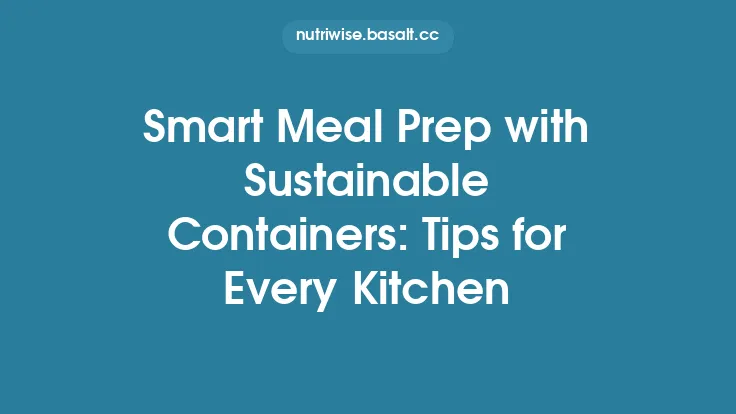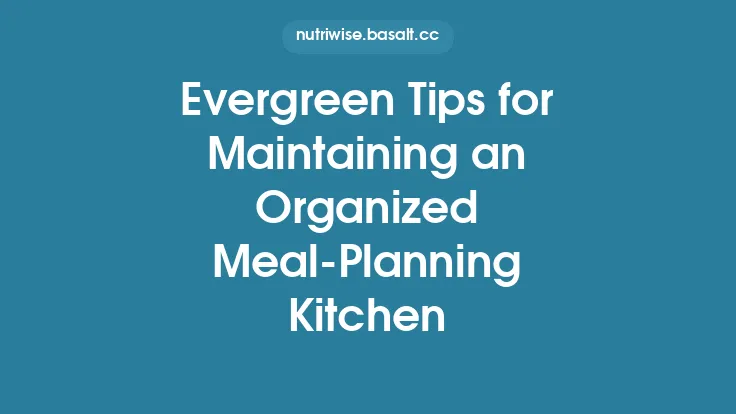Meal planning is a balancing act of creativity, nutrition, and efficiency. While a well‑thought‑out schedule and a tidy pantry are crucial, the real engine that turns a plan into a plated dish is the set of tools you reach for day after day. The right kitchen equipment can shave minutes off prep, preserve the quality of your ingredients, and make the entire process feel less like a chore and more like a streamlined routine. Below is a curated list of ten essential tools that every dedicated meal planner should have on hand. Each item is chosen for its versatility, durability, and ability to support a wide range of cooking styles—from quick weekday dinners to elaborate weekend feasts.
1. Multi‑Function Food Processor
A high‑quality food processor is the workhorse of any meal‑planning arsenal. Its ability to chop, slice, shred, puree, and even knead dough means you can handle everything from finely diced onions for a salsa to a smooth hummus for a snack prep. Look for models with a 10‑ to 12‑cup capacity, a powerful motor (minimum 600 W), and interchangeable blades. Stainless‑steel blades retain sharpness longer than plastic, and a wide feed tube reduces the need for pre‑cutting, saving precious prep time.
Technical tip: When planning meals that involve large batches of sauces or soups, use the processor’s “pulse” function to control texture. A short pulse yields a coarse chop ideal for chunky salsas, while a longer, steady blend creates a velvety puree perfect for baby food or base sauces.
2. Precision Digital Scale
Portion control is at the heart of consistent meal planning, especially when you’re tracking macros or cooking for a family with varying dietary needs. A digital scale that measures to at least 1 gram (0.04 oz) accuracy allows you to weigh proteins, grains, and produce with confidence. Choose a scale with a tare function, a clear LCD display, and a stainless‑steel platform that’s easy to clean.
Technical tip: Many modern scales offer Bluetooth connectivity, syncing weight data to nutrition apps. This integration eliminates manual entry and helps you maintain an accurate food log over weeks and months.
3. Set of High‑Quality Chef’s Knives
Sharp, well‑balanced knives are indispensable for efficient prep. A basic set should include a 8‑inch chef’s knife, a 4‑inch utility knife, and a 3‑inch paring knife. High‑carbon stainless steel blades hold an edge longer than standard stainless steel, while a full tang (the metal runs the full length of the handle) provides stability and reduces fatigue during extended chopping sessions.
Technical tip: Invest in a honing steel and a fine‑grit whetstone. Regular honing aligns the blade’s edge, while periodic sharpening on a whetstone restores the true cutting edge, ensuring consistent performance and safety.
4. Stackable, Airtight Storage Containers
Meal planners often batch‑cook and portion meals for the week. Stackable containers with airtight seals keep food fresh, prevent cross‑contamination, and make freezer organization a breeze. Look for containers made from BPA‑free, tempered glass or high‑grade polypropylene. Glass containers are microwave‑safe and do not retain odors, while polypropylene options are lighter and less prone to breakage.
Technical tip: Choose containers with a “snap‑lock” mechanism that creates a vacuum seal when the lid is pressed down. This design reduces oxidation, extending the shelf life of pre‑cut vegetables and cooked grains by up to 30 %.
5. Immersion Blender
An immersion (hand) blender is perfect for pureeing soups directly in the pot, emulsifying dressings, or whipping up quick smoothies. Its compact size means you can blend hot liquids without transferring them to a traditional blender, which reduces the risk of spills and burns. Look for models with variable speed controls and detachable stainless‑steel shafts for easy cleaning.
Technical tip: When making creamy soups, start on low speed to incorporate the ingredients, then gradually increase to high for a silky texture. The blade’s vortex action creates a uniform emulsion without the need for additional thickening agents.
6. Silicone Baking Mats
Reusable silicone mats replace parchment paper and aluminum foil for most baking tasks. They provide a non‑stick surface for roasting vegetables, baking cookies, or searing fish, and they can withstand temperatures from –40 °F (–40 °C) up to 480 °F (250 °C). Because they are dishwasher‑safe and reusable, they reduce waste and save money over time.
Technical tip: For optimal browning, lightly brush the mat with a high‑smoke‑point oil (e.g., avocado oil). This creates a subtle crust on roasted vegetables while still preventing sticking.
7. Adjustable Rolling Pin with Thickness Rings
Evenly rolled dough is essential for consistent cooking times, especially when preparing homemade pizza, flatbreads, or pastry crusts for weekly meal prep. An adjustable rolling pin equipped with removable thickness rings lets you set the exact diameter you need—ranging from 1 mm for ultra‑thin crackers to 5 mm for hearty pizza bases.
Technical tip: Use a light dusting of flour or rice flour on the dough and the pin to prevent sticking without adding excess flour, which can toughen the final product.
8. Instant‑Read Thermometer
Food safety and perfect doneness go hand‑in‑hand. An instant‑read probe thermometer provides rapid temperature feedback (usually within 2–3 seconds) and helps you avoid under‑ or over‑cooking proteins, grains, and baked goods. Look for models with a wide temperature range (−58 °F/−50 °C to 572 °F/300 °C) and a clear, backlit display.
Technical tip: For batch‑cooked proteins, insert the probe into the thickest part of the meat and wait for a stable reading. This ensures each portion reaches the safe internal temperature without sacrificing juiciness.
9. Heavy‑Duty Mandoline Slicer
A mandoline offers precision slicing, julienning, and crinkle‑cutting in seconds—ideal for creating uniform vegetable stacks for salads, quick‑cook stir‑fries, or aesthetically pleasing garnish. Choose a mandoline with multiple blade options, a non‑slip base, and a safety hand guard. Stainless‑steel blades maintain sharpness longer than ceramic alternatives.
Technical tip: When slicing delicate items like tomatoes, set the blade to the thickest setting and use a gentle, rocking motion. This reduces crushing and preserves the fruit’s structural integrity.
10. Programmable Slow Cooker or Multi‑Cooker
A programmable slow cooker (or a multi‑cookers like the Instant Pot) allows you to set meals to start cooking while you’re at work and finish just as you walk through the door. These devices can sauté, pressure‑cook, steam, and keep food warm, consolidating several appliances into one. Look for models with a stainless‑steel inner pot, multiple preset programs, and a clear LCD timer.
Technical tip: For meal‑prep batches, use the “keep warm” function after cooking to maintain temperature without overcooking. Pair this with insulated containers for transport to the office or school, ensuring food stays at a safe temperature for hours.
Integrating the Tools into Your Routine
Having these ten tools at your disposal creates a foundation for efficient, reliable meal planning. Here’s a quick workflow that demonstrates how they can work together:
- Plan & Portion – Use the digital scale to weigh proteins and grains according to your weekly macro goals.
- Prep Ingredients – Slice vegetables with the mandoline, chop aromatics in the food processor, and mince herbs with the chef’s knives.
- Cook Efficiently – Start a batch of soup in the slow cooker, using the immersion blender to finish the texture directly in the pot.
- Finish & Store – Portion the finished dishes into airtight containers, label (if needed) with a simple marker, and store in the fridge or freezer.
- Reheat & Serve – Reheat portions using the microwave (glass containers) or a quick sauté in a pan, checking temperature with the instant‑read thermometer for safety.
By aligning each tool with a specific step in the meal‑planning process, you eliminate bottlenecks, reduce waste, and free up mental space for creativity in the kitchen. The result is a smoother, more enjoyable cooking experience that supports healthy eating habits day after day.



